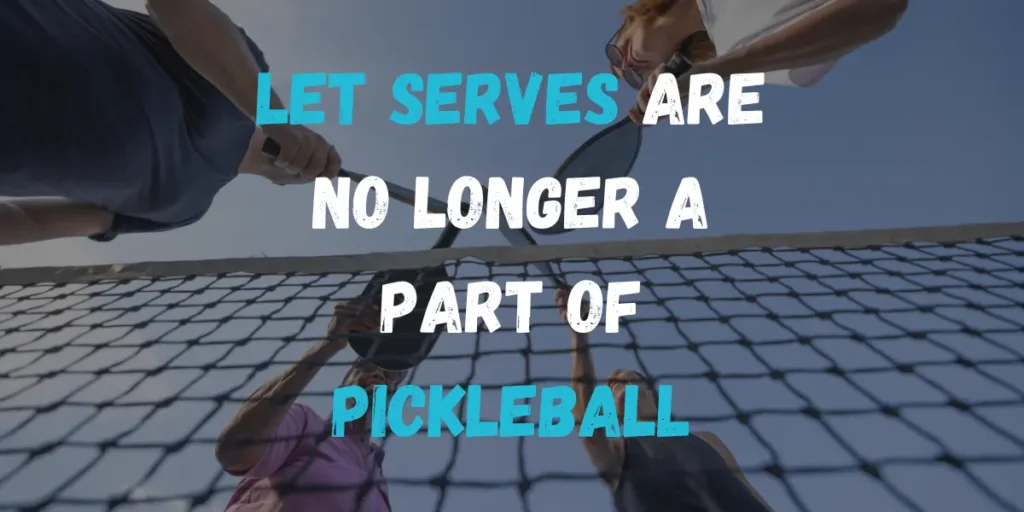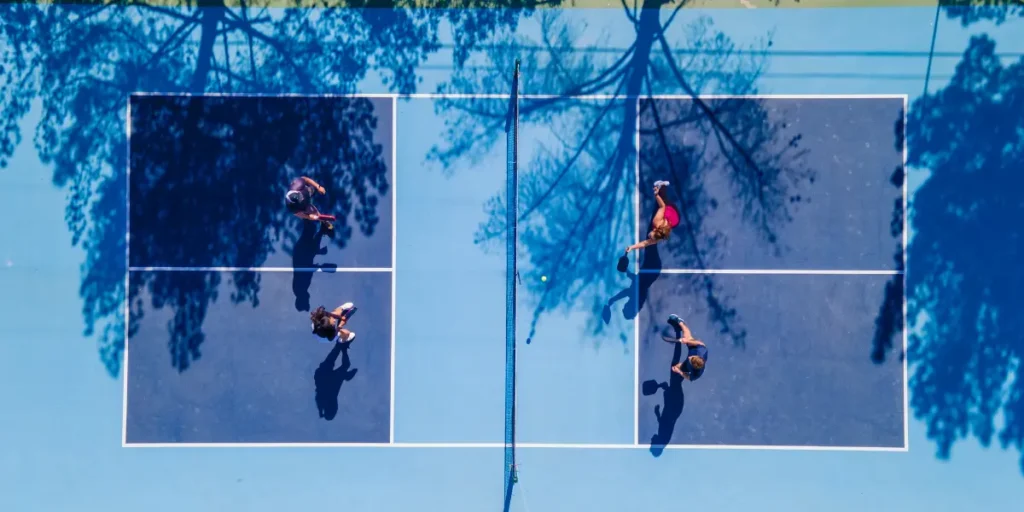Imagine you’re in the middle of an intense pickleball match, you serve the ball, and it lightly clips the net before landing in the correct service box. In most racket sports, this would be called a “let,” allowing the server to retake the serve without penalty.
But does pickleball have lets? The answer might surprise many players, especially those new to the game or transitioning from tennis.
Pickleball has undergone several rule changes over the years, including the removal of the let serve rule. Understanding the concept of lets, why they were eliminated, and how they impact the game is essential for both casual and competitive players.
In this article, we’ll explore everything about lets in pickleball, from its past usage to the current serving rules.
What is a Let in Pickleball?
A let-in racket sport traditionally refers to a situation where a point is replayed due to interference or an unintended event. In the case of pickleball, a let serve used to occur when the ball struck the net but still landed in the correct service box. Under old rules, players were allowed to redo their serve without penalty.
However, this rule no longer exists in pickleball. As of 2021, the USA Pickleball Association (USAPA) officially removed let serves from the game. This means that if the ball hits the net on a serve and still lands in the correct service box, the play continues as usual without a replay.
Old vs. New Rule Comparison:
| Rule Aspect | Old Rule (Before 2021) | New Rule (After 2021) |
|---|---|---|
| Let Serve Allowed? | Yes | No |
| Ball Hits the Net & Lands in the Service Box | Replay Serve | Play Continues |
| Ball Hits Net & Lands Outside Service Box | Fault | Fault |
This rule change was implemented to reduce game delays and avoid unnecessary disputes about whether a serve was a let or not.
Is There a Let Serve in Pickleball?

Let serves are no longer a part of pickleball. Before 2021, if a serve hit the net and landed in the correct service area, the server was allowed to redo the serve without penalty.
However, under the new rule, a serve that touches the net and still lands within the correct service box is considered legal, and play continues without interruption.
If the ball touches the net and fails to land within the proper service area, it is ruled as a fault, just like any other incorrect serve.
Why Was the Let Serve Rule Removed?
The removal of the let serve rule was primarily aimed at eliminating unnecessary disputes and making the game more continuous. In recreational and competitive play, debates often arose over whether a serve should be replayed due to a let.
The rule change eliminates this uncertainty and ensures that gameplay remains fluid. Additionally, by removing let serves, pickleball maintains a more structured and predictable set of rules that are easy to follow across all levels of play.
This rule change was initially met with mixed reactions, but most players have now adapted to it. The new rule eliminates unnecessary pauses
What Happens If the Serve Hits the Net Now?
If the ball clips the net during a serve, its outcome depends on where it lands. If the ball lands in the correct service box after hitting the net, it is considered a valid serve, and the game proceeds without any stoppage.
However, if the ball touches the net and lands outside the service box or within the kitchen (non-volley zone), the serve is ruled a fault, and the server loses the opportunity to continue.
This rule change means that players must be prepared for unexpected net deflections, as serves that touch the net but land correctly are still in play.
The removal of the let serve rule ensures that there are no disputes over whether a serve should be replayed, making the game smoother and more continuous.
For an in-depth explanation Click the Link Can You Hit the Net on a Serve in Pickleball, where we break down this scenario in detail.
Examples of Legal vs. Illegal Serves
To clarify how the new rule applies, let’s look at a few examples:
Legal Serves:
✅ The ball hits the net but lands in the correct service box. Play continues.
✅ The ball clears the net and lands in the correct service box without touching the kitchen.
✅ The serve is executed with a proper underhand motion and lands within the allowed area.
Illegal Serves (Faults):
❌ The ball hits the net and lands outside the correct service box.
❌The ball hits the net and lands in the non-volley zone (kitchen).
❌ The server steps on or beyond the baseline while serving.
Do You Play Lets in Pickleball?
Since the rule change, many players wonder whether lets are still played in pickleball. The answer is no—lets are no longer part of the game, at least for serving. A serve is either valid or a fault, with no option to replay it. This rule applies at all levels, from casual games to professional tournaments.

However, rare situations may require a point to be replayed, such as when outside interference occurs, like a stray ball rolling onto the court. In such cases, the referee may stop play, but this is different from a traditional let serve.
Some players, particularly those with a tennis background, take time to adjust to this change. However, removing let serves has made pickleball more consistent by eliminating unnecessary pauses, ensuring smoother and uninterrupted gameplay.
Pickleball Serve Rules After the Let Rule Removal
With the removal of let serves, players must follow the updated serving rules to maintain fair play. A legal serve must be made underhand, with the paddle below the waist at contact, and must land diagonally in the opponent’s service box.
Play continues if a serve hits the net but lands in the correct service box. However, if it lands outside the service area or in the kitchen, it is a fault, resulting in a lost serve. Precision in serving is essential, as faults can shift momentum in a match.
Another key rule is the “two-bounce rule,” requiring the ball to bounce once on each side before volleys are allowed. This prevents immediate net play and ensures fair rallies.
The removal of let serves has made gameplay smoother by reducing unnecessary stoppages, creating a more consistent experience for all players.
Common Misconceptions About Lets in Pickleball
Despite the rule change, many players still mistakenly believe that lets are played in pickleball. Often, players transitioning from tennis or other racket sports may incorrectly call for replays when a serve touches the net.
Clarifying this confusion is essential for ensuring all players follow current rules accurately. The let serve no longer exists, and all net-touching serves landing in the service box remain in play.
Benefits of Removing the Let Rule in Pickleball

Imagine a close pickleball match where the score is tied, and Player A carefully serves the ball, barely clears the net, and it perfectly lands in Player B’s service box. Surprisingly, Player B, unable to return the shot, immediately line calls a let, claiming the ball hit the top of the net.
Suddenly, an accusation emerges, with Player A feeling unfairly penalized and even accused of cheating, while Player B denies it and insists on having the ball re-served. As someone who’s been in similar real-life situations, I can confidently say these scenarios frequently cause confusion and lead to unnecessary arguments and disputes on the court.
The recent rule changes in pickleball were thoughtfully intended to address exactly this kind of frustrating scenario. By completely removing the let rule, the game becomes more straightforward, creating a more consistent application of the rules.
This change effectively reduces interruptions that disturb the flow of the game, resulting in smoother play and a far more enjoyable experience.
Players now have a better understanding of the simplified overall rulebook, allowing matches—even those without a referee present—to proceed without confusion or needless accusations.
FAQs
No, redo serves are not permitted. Each serve must be executed correctly the first time; otherwise, it is considered a fault. Players do not receive second chances, emphasizing precision and consistency from the outset.
Pickleball removed lets primarily to minimize disputes and reduce delays during matches. This change fosters smoother gameplay and ensures consistent rules, making it easier for players of all skill levels to follow and enjoy the game.
No, professional players follow the same no-let rule as recreational players. This uniform approach simplifies the understanding of the game, ensuring fairness and consistency at every level of competition.
Yes, under current rules, a serve can legally touch the net if it still lands within the appropriate service box. Players must be prepared to react swiftly, as these serves are valid and remain in play.
Yes, but only under unique circumstances, such as external interference (e.g., another ball entering the court). In these rare cases, a referee may stop play and permit a replay to maintain fairness.
Conclusion
The removal of the let serve rule in pickleball has significantly simplified gameplay, enhancing fairness and enjoyment for all players. By eliminating the confusion and disputes caused by let serves, matches now flow smoothly without unnecessary interruptions.
Players of all skill levels benefit from clear and consistent rules, making the game more accessible and enjoyable.
This rule change has helped pickleball grow into one of the most popular racket sports today, attracting newcomers and seasoned athletes alike.
Embracing these updated rules ensures a more streamlined and enjoyable experience on the court, allowing everyone to focus purely on strategy, skill, and enjoyment.

